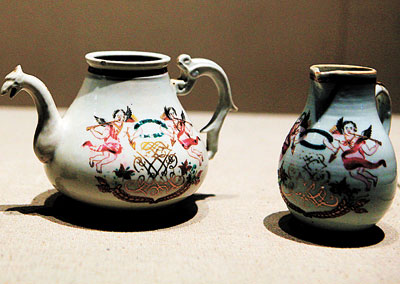|

Cao Zhen
caozhen0806@126.com
MORE than 100 pieces of armorial porcelains, a kind of Chinese ceramic wares made exclusively for export in the 17th to 19th centuries, are on display at the Shenzhen Museum in Civic Center, showing off a fascinating historical review of East-West interaction.
The porcelains, provided by various Shenzhen collectors, include dishes, spice boxes, tureens, teapots, jugs and cups decorated with armorial designs commissioned by buyers from Portugal, Spain, the Netherlands, Italy, England, France, the United States, Denmark, Sweden and Russia. Noted users of the porcelains include Louis XVI of France, Russia’s Catherine the Great and Prussia’s Frederick the Great.
The porcelains were made, glazed and fired in Jingdezhen, Jiangxi Province, but decorated with enamels in Canton (today’s Guangzhou) prior to export by sea, according to Huang Yangxing, an ancient art researcher at the Shenzhen Museum. Drawings of coats of arms were provided by the buyers and dispatched to China to be copied as faithfully as possible. The resulting wares, sometimes added with well-painted Oriental designs, were shipped back to Europe and, from the late 18th century, to North America.
“Interaction between Oriental porcelain and Western coat of arms is a fascinating subject that tells us much about trade, creativity, craftsmanship and the appeal of the exotic,” said Huang. “Since the porcelains were commissioned by Western royal and aristocratic families, armies, or big companies, their quality was much finer than other exported porcelains.”
Coats of arms, which were mostly family or army badges serving the purpose of identification and decoration, appeared on European pottery from the Renaissance with examples seen on Italian majolica, slipware and Dutch delftware. European crests on Chinese porcelain can be found as early as the 16th century. After France’s Louis XIV ordered a batch of armorial porcelains from Guangzhou around the end of the 17th century, many European nations’ trading companies in the Far East, including the famous Dutch East India Company, began importing Chinese armorial porcelains.
Early armorial porcelains were painted in cobalt blue only, and this monochrome palette made it extremely difficult to depict a legible coat of arms. Highly decorative armorial designs required Chinese craftsmen to develop more complicated polychrome enamels for detailed, accurate coats of arms, said Huang.
With the appearance of porcelain factories in Europe in the early 18th century, the demand for Chinese export porcelain began to diminish. The improved European ceramic makers managed to copy from Chinese techniques, such as thin, light but strong styles and decorated with Oriental designs. By the late 19th century, competition from new European factories with industrialized mass-production took its toll.
Huang said armorial porcelains formed a small part of Chinese export porcelains, so they are rarely known by modern Chinese and most armorial porcelains are in the hands of overseas collectors. In today’s Chinese auction market, armorial porcelains are not as popular as other made-for-export ceramic objects.
“Armorial porcelains are popular in the foreign auction market because of Westerners’ fondness of coats of arms. This is a cultural difference between Western and Chinese collectors. Chinese people like porcelains with bird, flower or figure designs,” said Huang.
But Huang also noted that since armorial porcelains were commissioned exports, which not only have exquisite designs and finer quality but are also symbols of historical East-West interaction. “I believe armorial porcelain’s value would increase in the Chinese auction market if more people know about it because it tells us how Chinese and European cultures were integrated in a long and complicated history.”Dates: Until March 9
Hours: 10 a.m.-6 p.m. Closed Mondays
Venue: Shenzhen Museum, Block A, Civic Center, Futian District
(福田区市民中心A区深圳博物馆新馆)
Metro: Shekou or Longhua Line, Civic Center Station (市民中心站), Exit C
|

